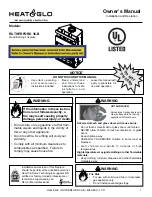
NOTE: DIAGRAMS & ILLUSTRATIONS ARE NOT TO SCALE.
4
OPERATING THE FIREPLACE
Fuel
The Villa Vista™ fireplace is designed to work
best when fuelled with seasoned cordwood.
Hardwoods are preferred to softwoods since the
energy content of wood is relative to its density.
Hardwoods will result in a longer burning fire
and less frequent refuelling.
A moisture content of 15% to 20% (seasoned)
is recommended. Excessively wet wood will
be difficult to burn and will result in lower ef-
ficiency, increased creosoting and plugging of
the catalytic combustor. Excessively dry wood
will burn well but will also have higher emissions
and shorter burning time.
Do not burn scrap or garbage, treated wood or
wood such as driftwood from the ocean which
has been exposed to salt or other chemicals.
Salt or chemicals can corrode the firebox and
can shorten the life of the catalytic combustor.
Do not burn large amounts of paper, cardboard,
tree branches or building construction materials.
Intense firing with these materials may overheat
the fireplace, causing damage to the unit, a fire
or even possibly igniting a chimney fire if the
chimney is creosoted.
Overheating the unit above 1000° C (1800º F)
is harmful for the catalytic combustor, it can
damage the catalyst coating and can cause
cracking of the substrate. Looking through
the upper louvers, if the top of the firebox is
glowing, the unit is overheating.
First Fires
Before using the fireplace make sure to remove
the plastic wrapping on the doors. Remove all
remaining glue from labels with mild soap.
Gold and Nickel plated doors must be cleaned
and free of fingerprints.
The first 5 or 6 fires should be small fires of
short duration (about 30 to 60 minutes). This
will help cure the refractory bricks. Ashes that
will accumulate in the ashtray will protect it from
intense heat. The first fires may produce slight
smoking and some odor due to drying of the
paint and steel and any dust accumulated on the
fireplace will burn off at this time. It may set off
a smoke alarm located in the same room. For
this reason the room should be well ventilated
for the first few fires.
Catalytic Combustor
The Villa Vista fireplace is equipped with a
catalytic combustor. Unburned by-products of
the wood fire are burned at lower temperatures
as they pass through the combustor resulting
in less pollution, reduced creosote and higher
efficiency. In order to have the catalyst work-
ing, temperatures of the flue gases entering
the combustor have to be higher than 260° C
(500° F). That is why the unit is equipped with
a by-pass damper that allows the draft air to
by-pass the catalytic combustor. Opening the
by-pass damper control increases the draft
allowing the unit to achieve proper operating
temperatures during a cold start-up. It also
provides more draft to prevent smoke spillage
when the door is opened.
When the catalyst light-off conditions are
achieved, the combustor will keep on going
until it runs out of smoke. Note that the catalyst
does not need to be glowing to be working, it
can work very well at temperatures well below
the 538° C (1000° F) level at which it will begin
to glow. The best way to see if the catalyst is
active is to take a look at what is coming out
of the chimney. If the catalytic combustor is
working you will see some white water vapor
coming out, compared to a more brown/gray
smoke when the by-pass is opened. Do not burn
any chemical chimney cleaner; it can make the
catalyst inactive.
Combustion Control
There is no flue damper in the Villa Vista fire-
place. As is common with air tight stoves, the
combustion air damper controls the air enter-
ing the firebox. This allows for a more precise
control of the fire. The combustion air damper
knob is located on the left of the bottom louver
(
Figure 1
). It is opened when moved completely
to the left. This control should be in the closed
position when the fireplace is not in use. This
will minimize air leakage up the chimney. The
combustion air control and the by-pass damper
control must be opened before opening the
door to minimize the possibility of back draft
coming into the room.
Figure 1
CLOSED
OPEN
By-Pass
Combustion
Air Control





































